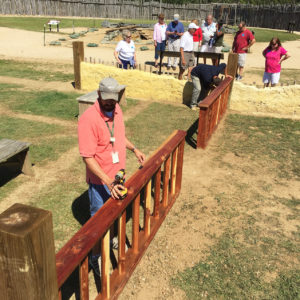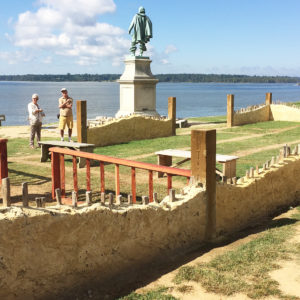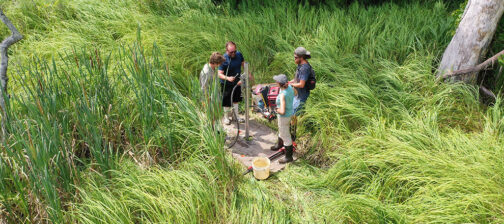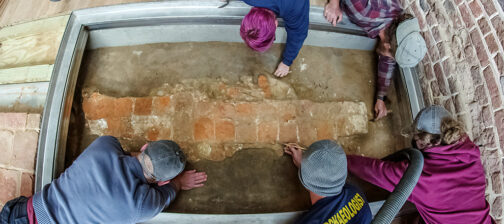Building on this spring’s construction of a mud and stud outline for the 1608 church, Jamestown Rediscovery archaeologists made a cedar railing in September to mark the church’s chancel.
The new railing evokes the one that Pocahontas and English tobacco grower John Rolfe stood at to be married in 1614. This railing also frames the space where four of the founders of Jamestown were buried—the men identified in a July press conference held by Jamestown Rediscovery and the Smithsonian National Museum of Natural History.
“Why do we put up the chancel railing? It’s to give it a sense of space and place,” said Senior Staff Archaeologist Dave Givens. “We are memorializing this place for our visitors. Archaeology can change the past narrative, and then we can re-inject it into the present, and that changes the future.”
The discovery of the footprint of this church was named one of the Top 10 archaeological discoveries in the world in 2010 by Archaeology Magazine. It was the first significant church structure in an English colony in North America. It was made of wood with walls of a mud covering, what is called “mud and stud” architecture.
Givens built the cedar railing with Senior Conservator Michael Lavin and archaeologist Bob Chartrand. They planed the rough cut lumber and set it in place on the church site so that it meets the requirements for the Americans with Disabilities Act.
The 24-by-60 foot outline of the church that visitors now see above ground includes large posts that mark where Jamestown Rediscovery archaeologists found major structural posts matching the dimensions of the church recorded by Secretary of the colony William Strachey. He described the 1608 church this way: “In the middest [of the fort] is a . . . pretty chapel. . . . It is in length threescore foot, in breadth twenty-four, and shall have a chancel in it of cedar. . . .” The posts were large enough to support a heavy thatched roof and would have made the church the largest building in the fort in the first years of the settlement.
Givens said, “Why do we go places? Why do we elaborate on anniversaries? Because the memory of place is important to us today. The trajectory of the narrative is changed by what we do here.”
Visitors can now stand at the railing and see the four crosses that mark where the founders were buried in the church 400 years ago. Jamestown Rediscovery researchers have identified them as the Rev. Robert Hunt, the first minister at Jamestown; Sir Ferdinando Wainman, the first English knight buried in North America; Captain Gabriel Archer, who frequently clashed with Captain John Smith; and Captain William West, a relative of Lord De La Warr.
Plans are being discussed to memorialize the four men within the chancel space. And research continues on the clues found within the burials.
For example, three of the four men buried in the chancel were interred in wooden coffins. Only traces of the wood survived in the acidic tidewater soil. Givens noted, “We did have some surviving coffin wood underneath the silver box that was encountered. Chris Swan at The Colonial Williamsburg Foundation was able to ID it as a hardwood, white oak. That’s pretty amazing that through a small bit of evidence we were able to understand that.”







